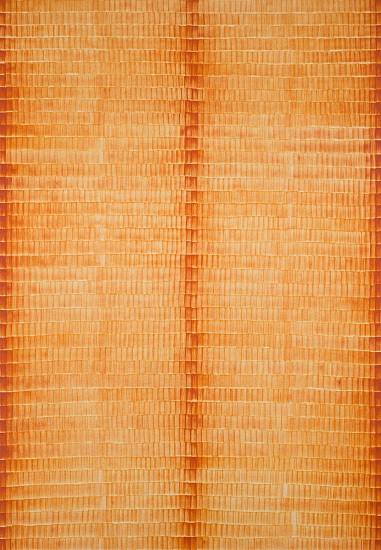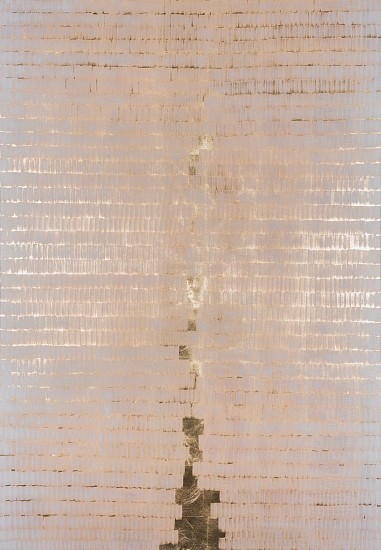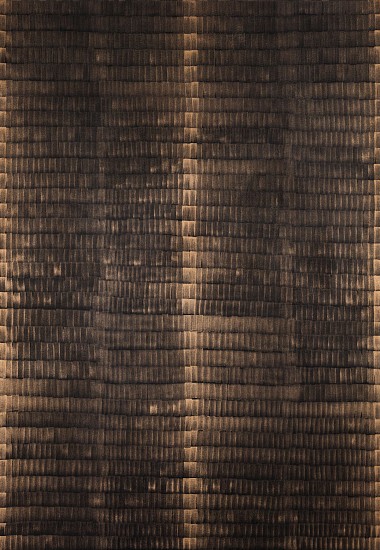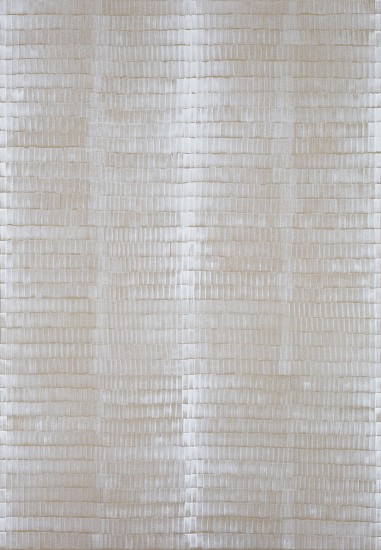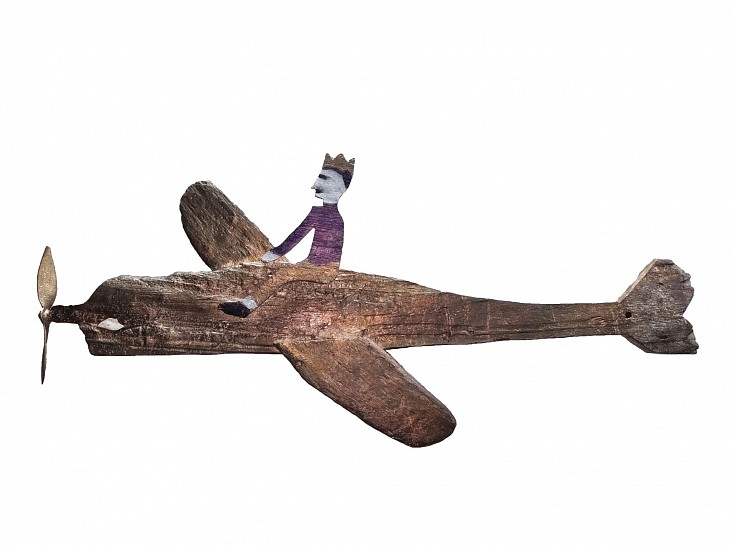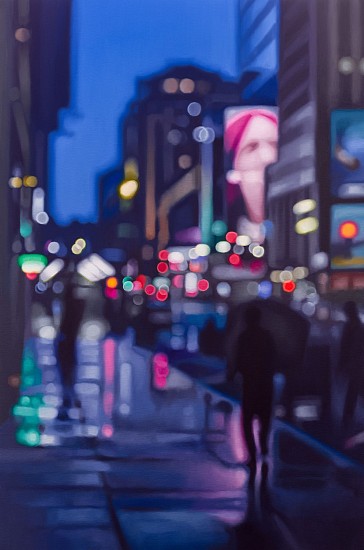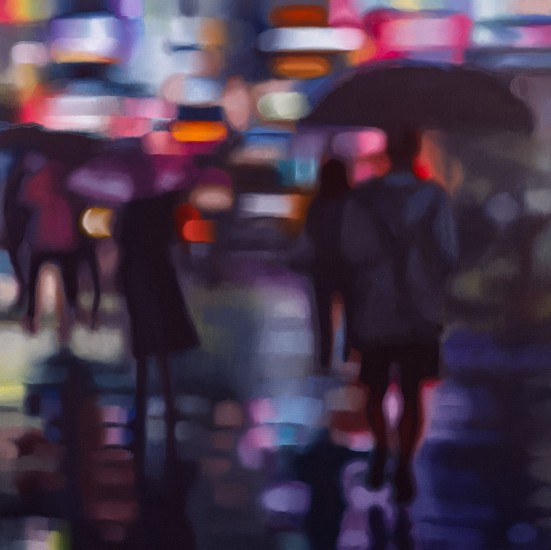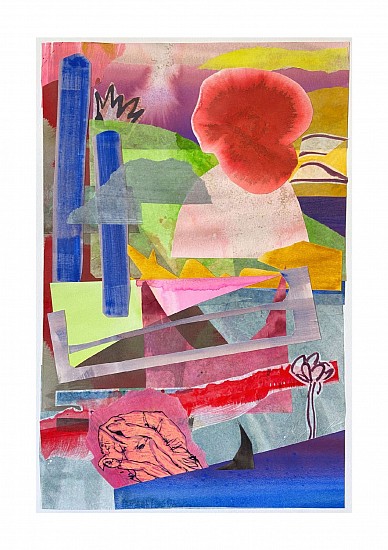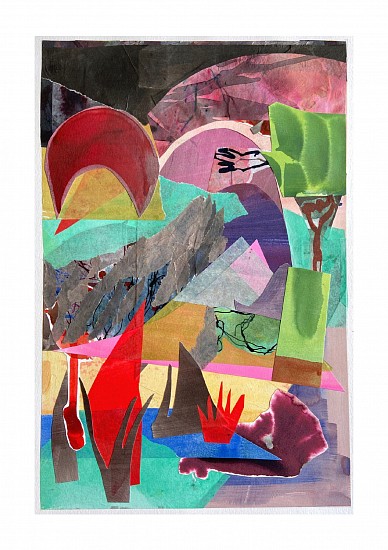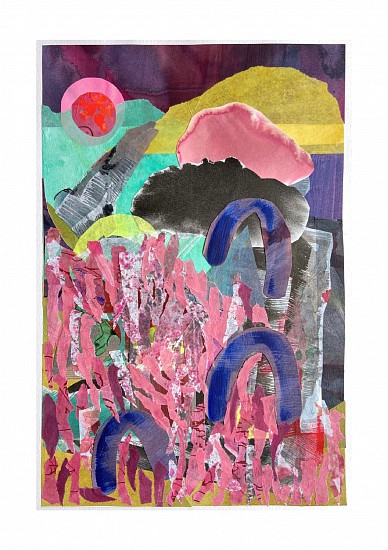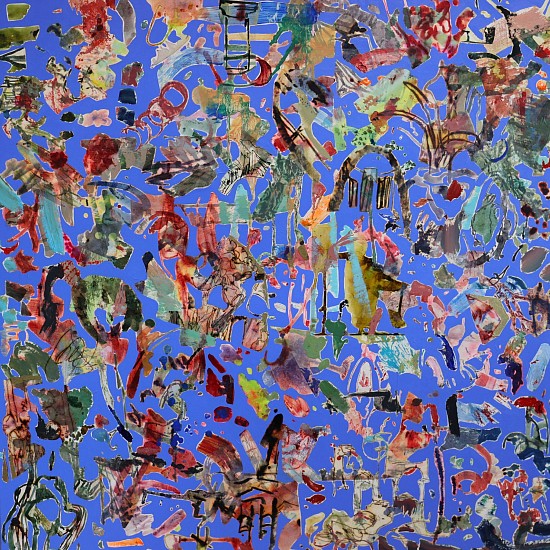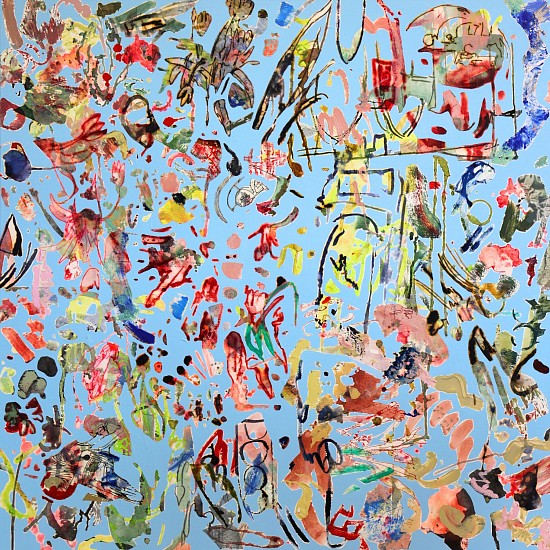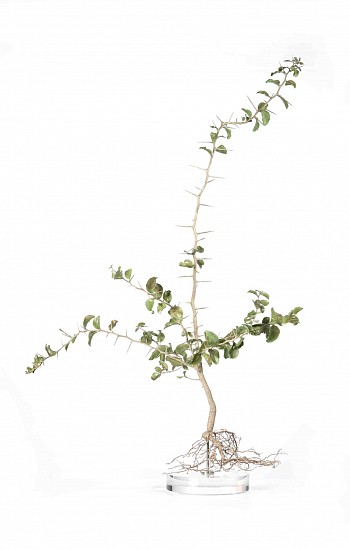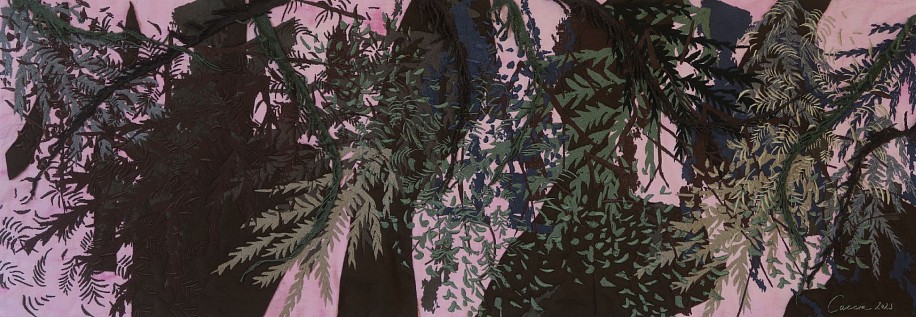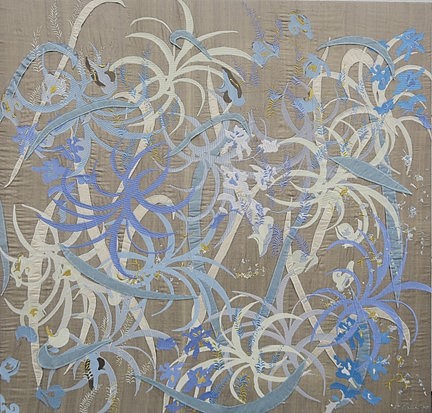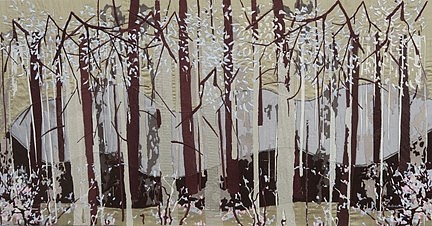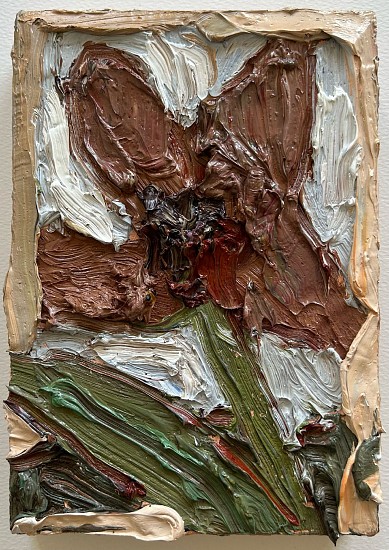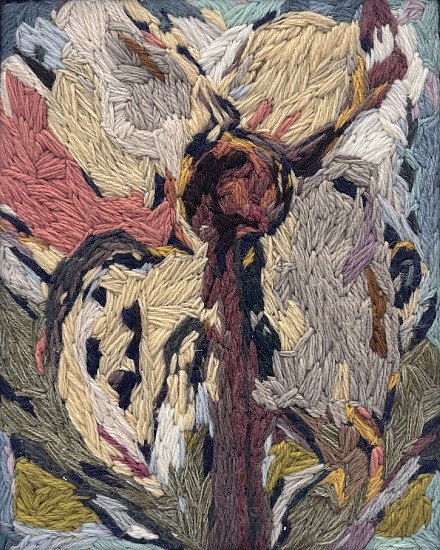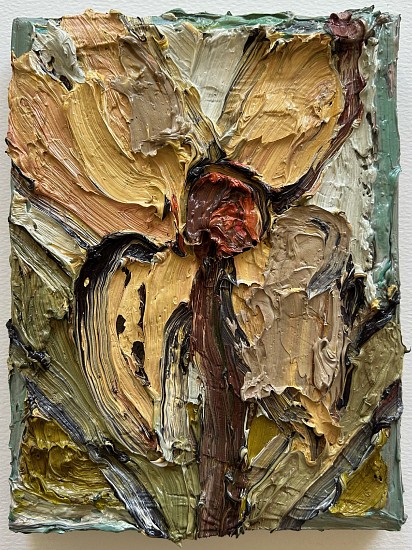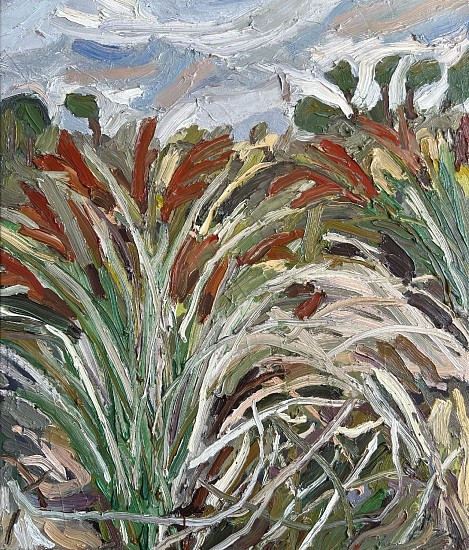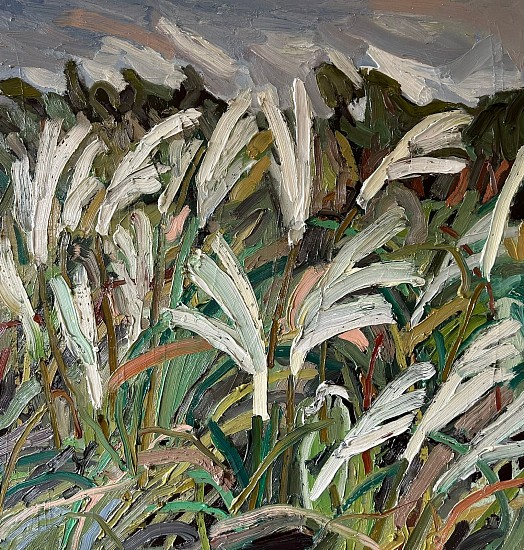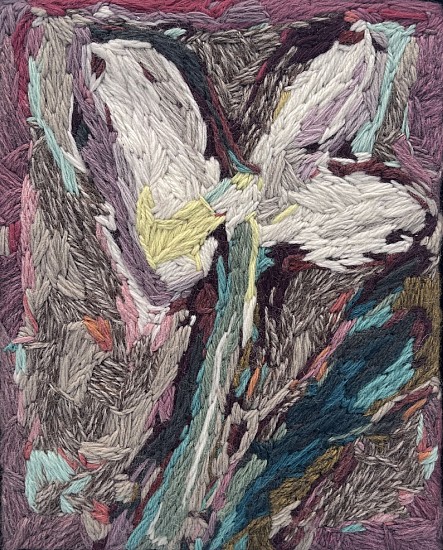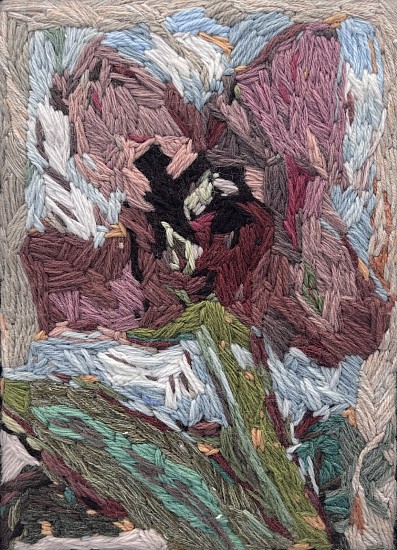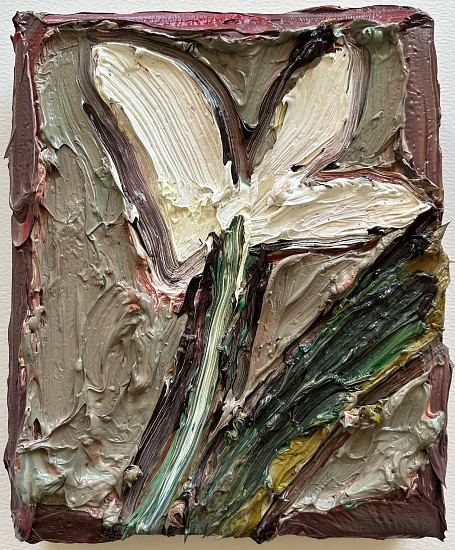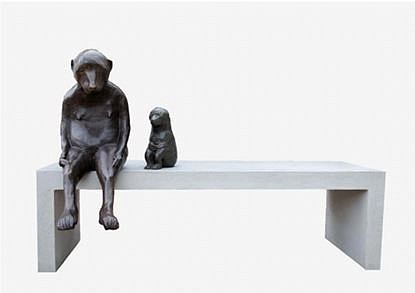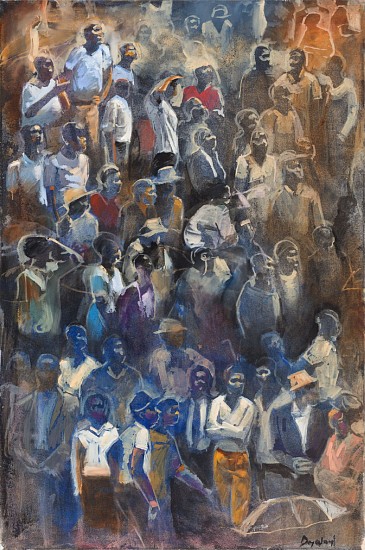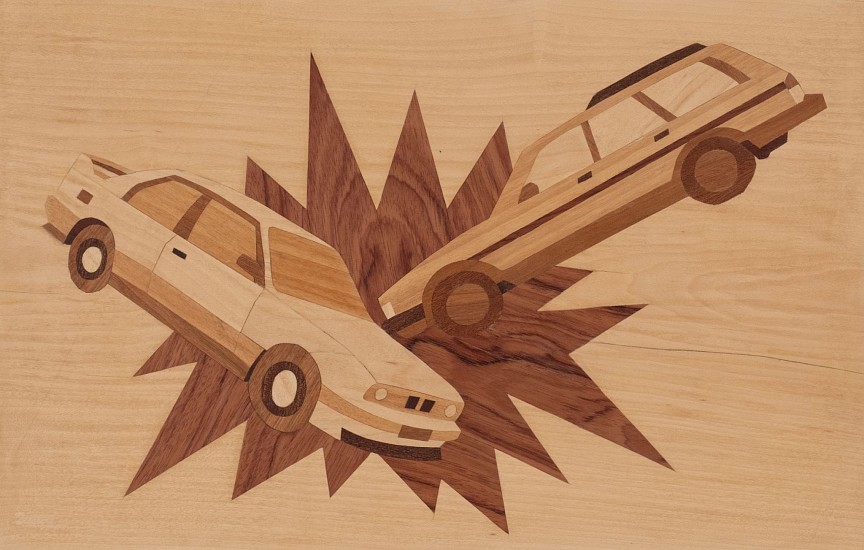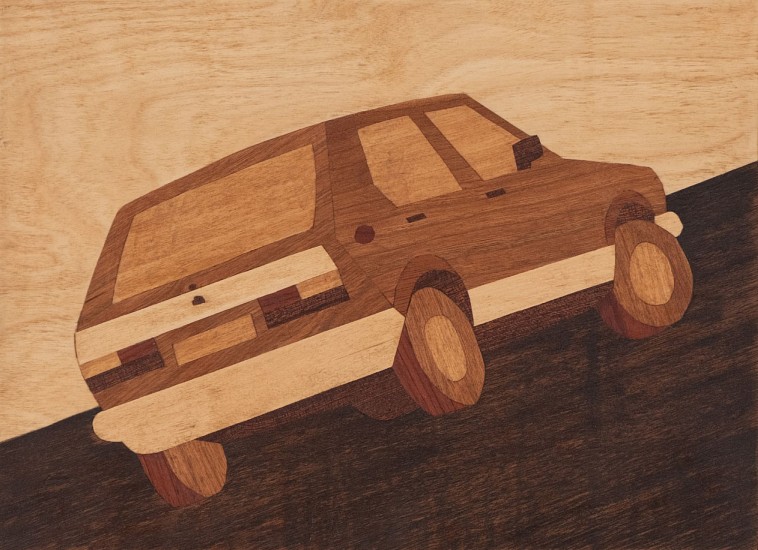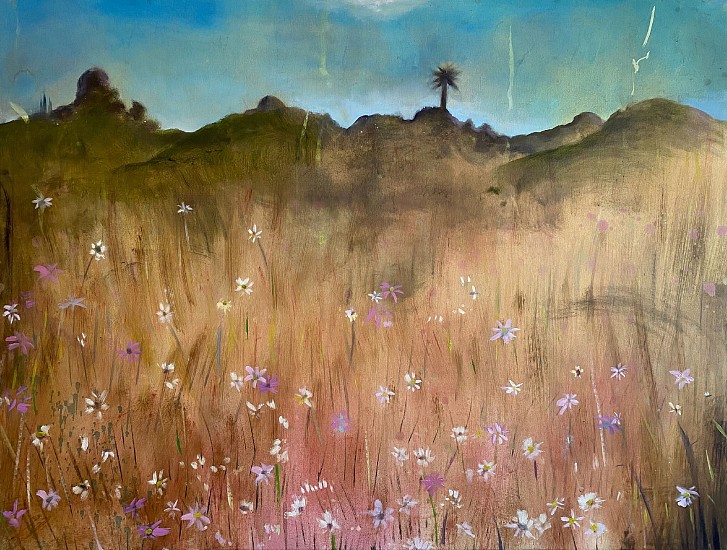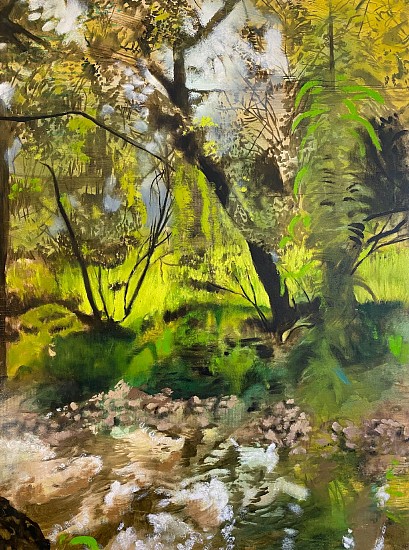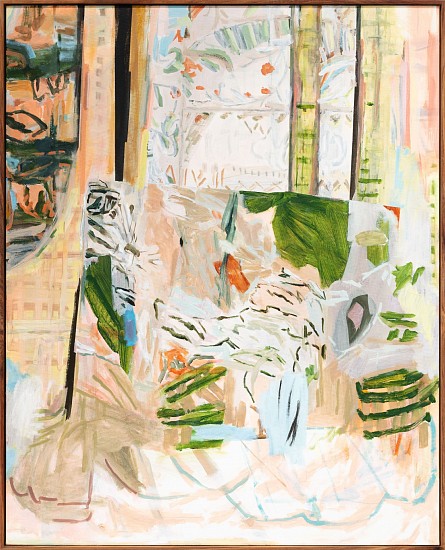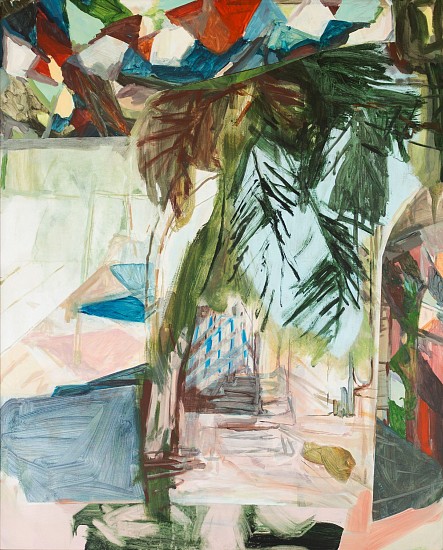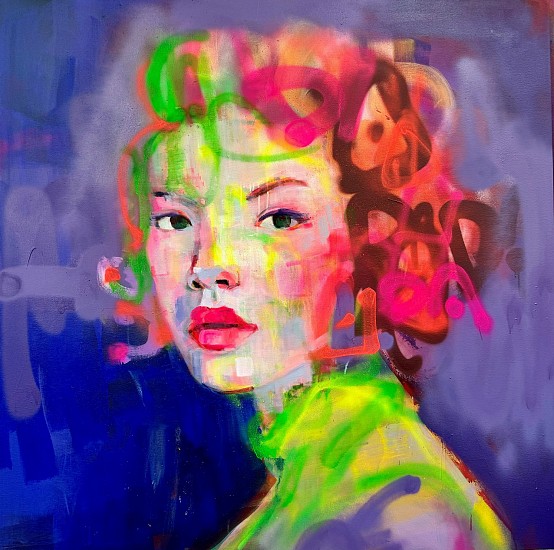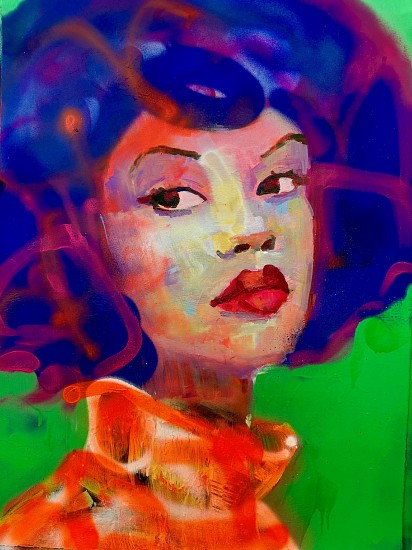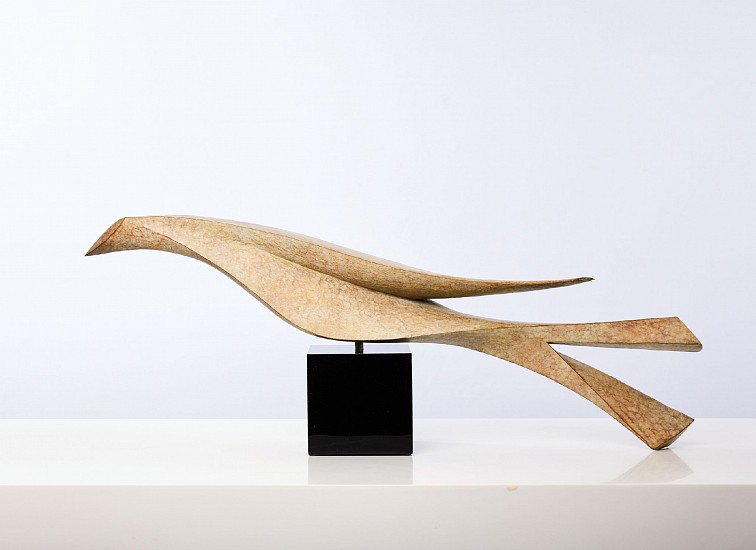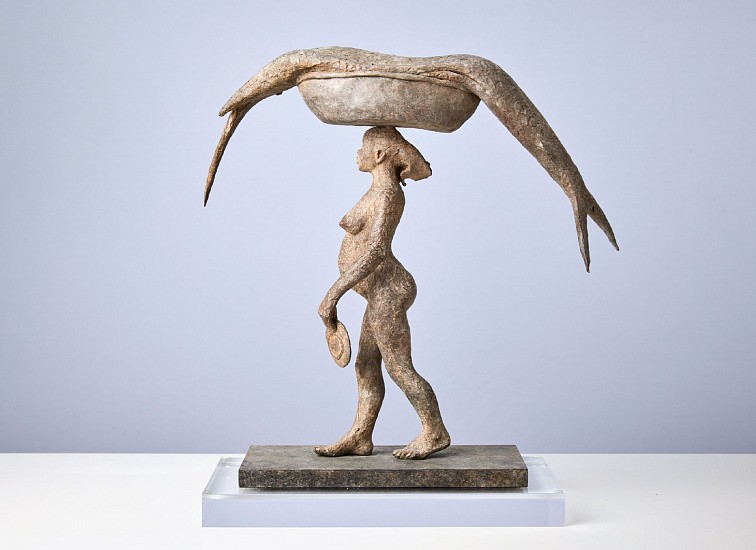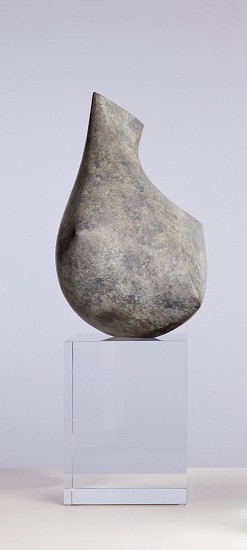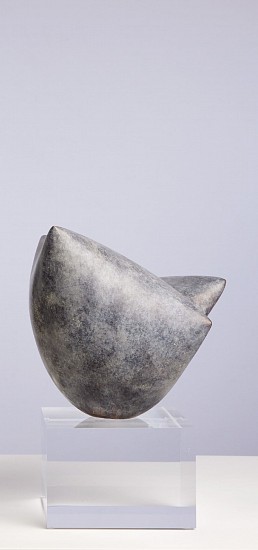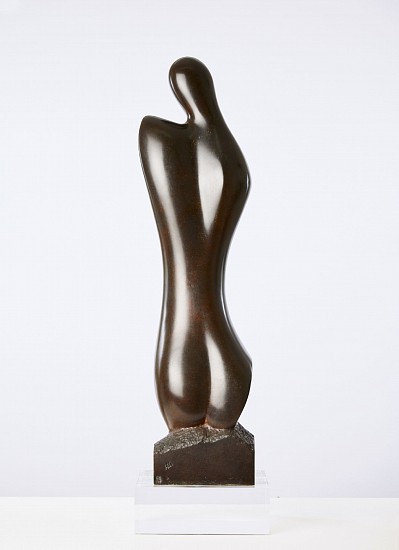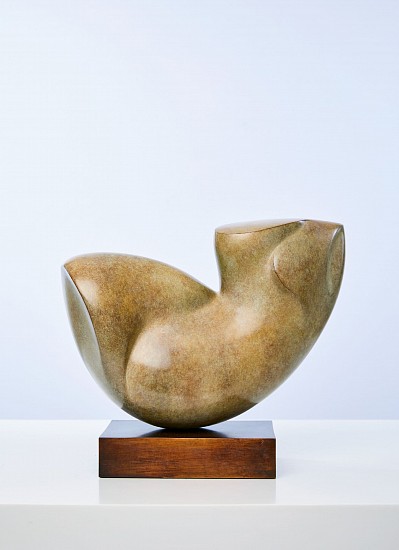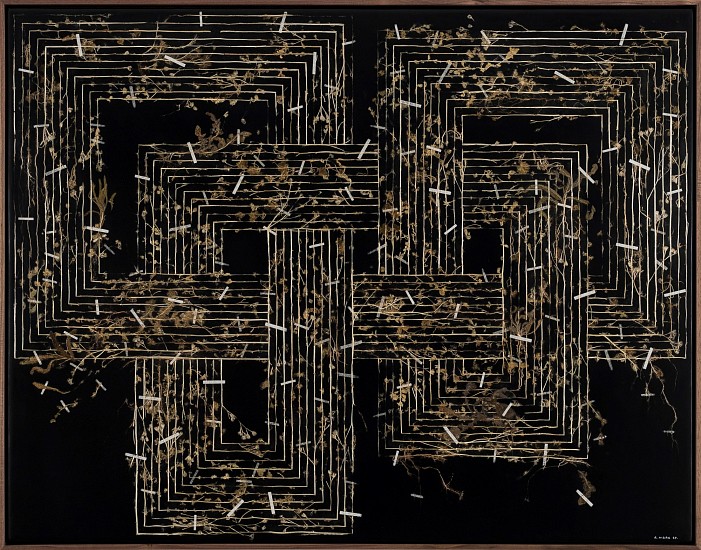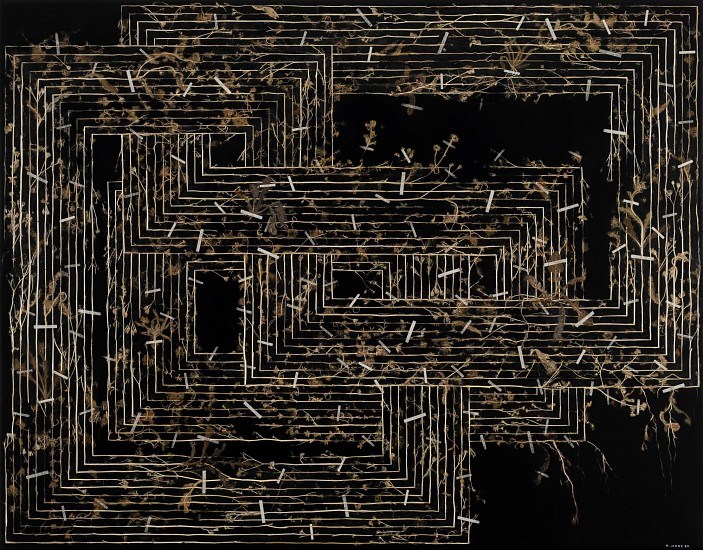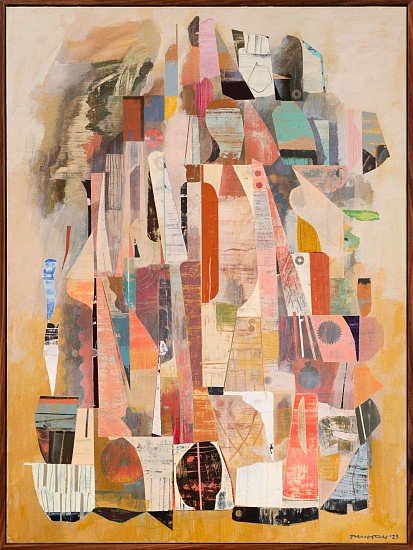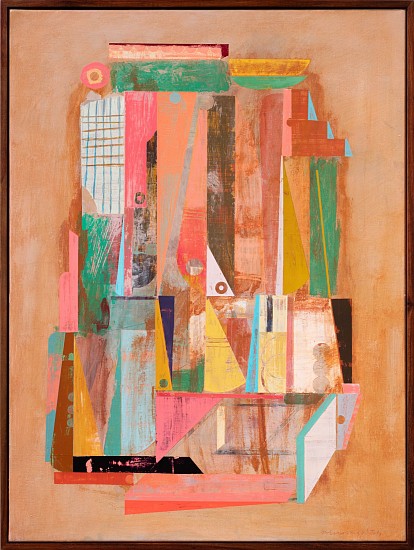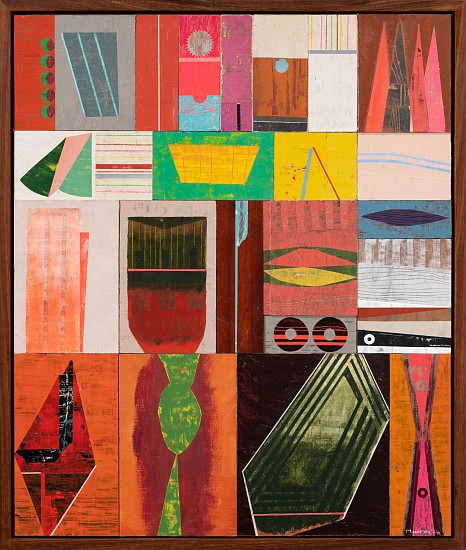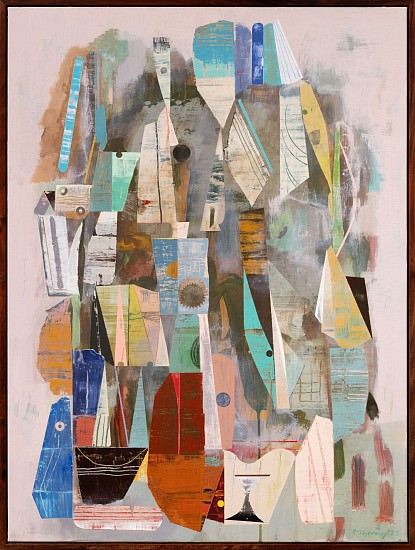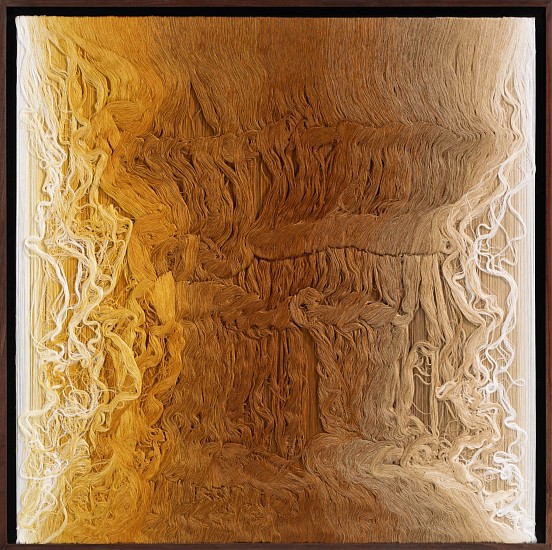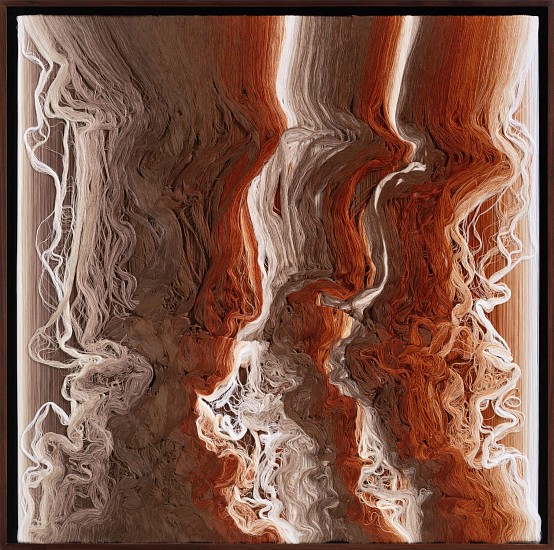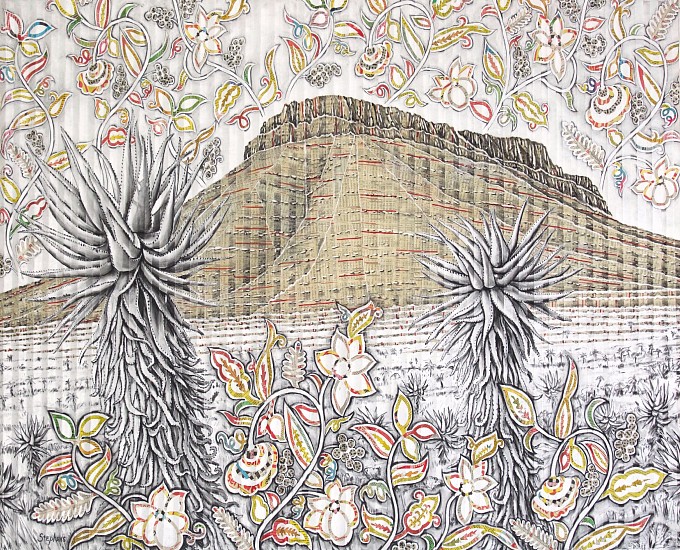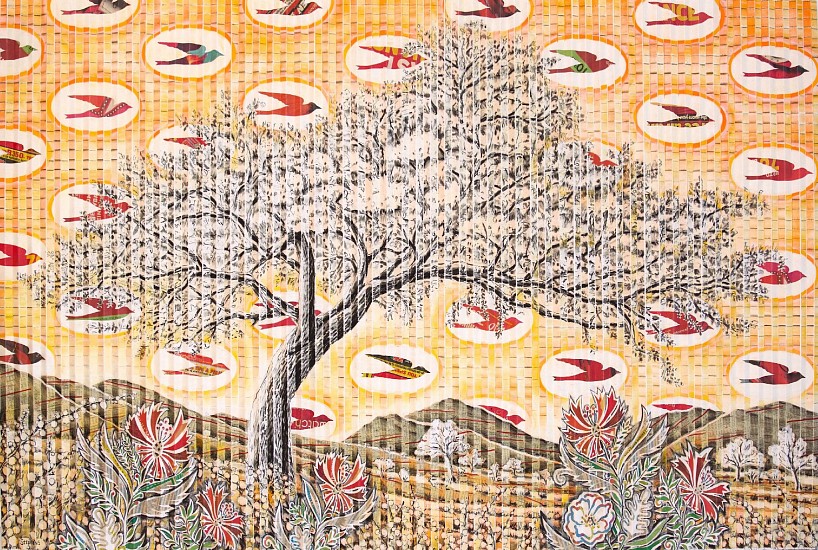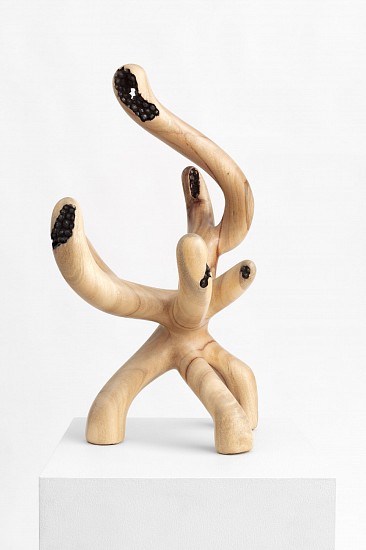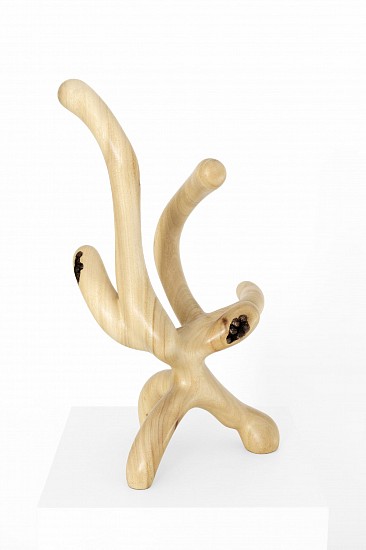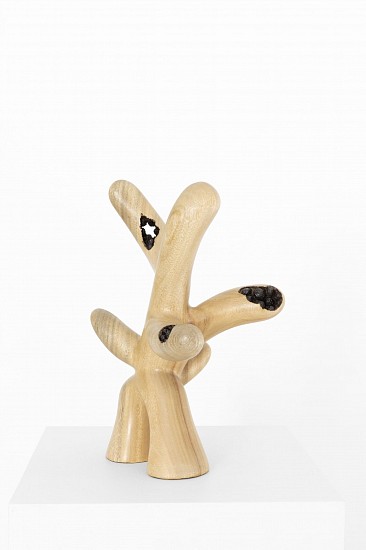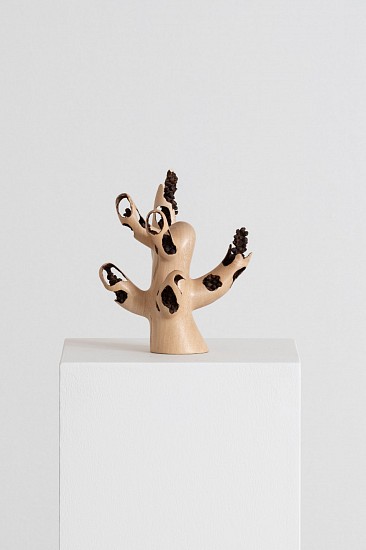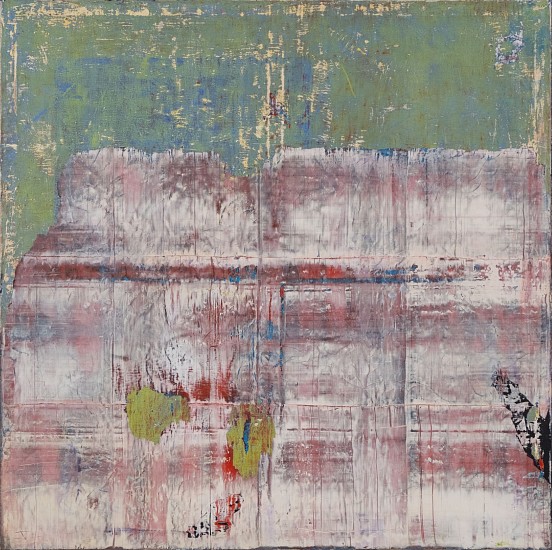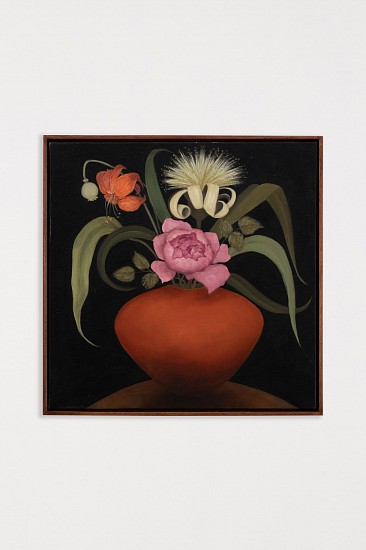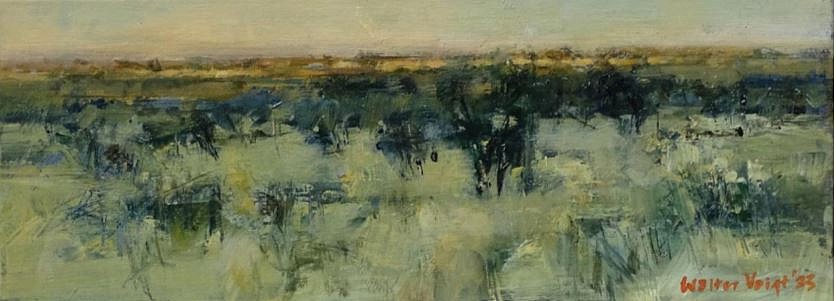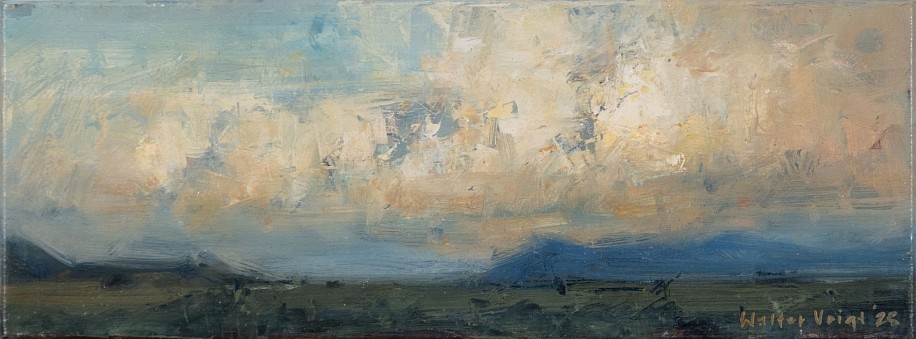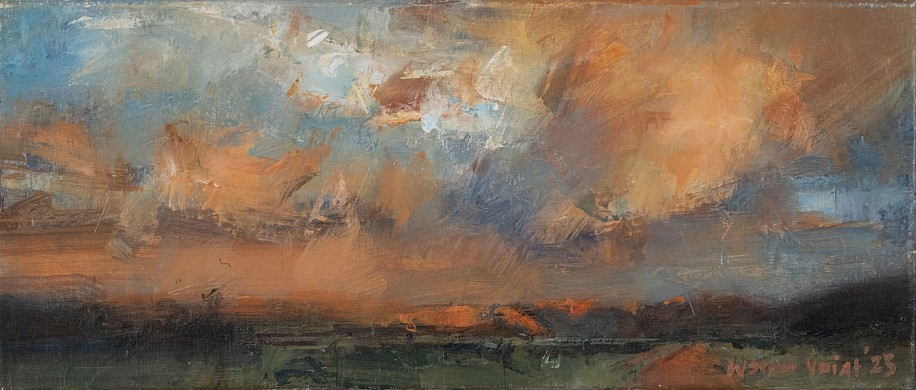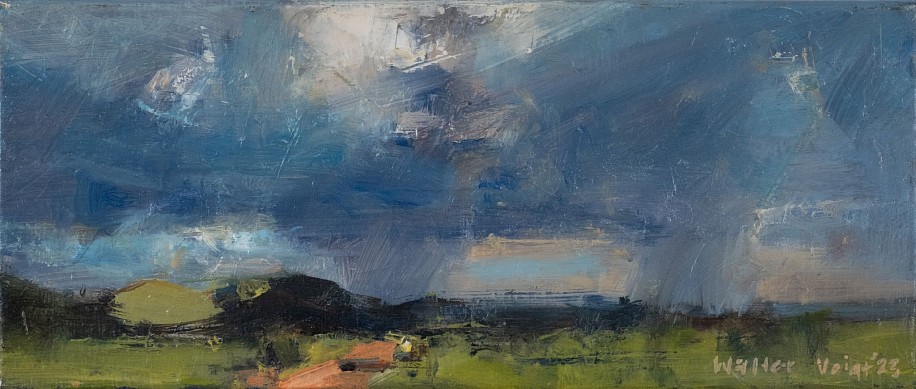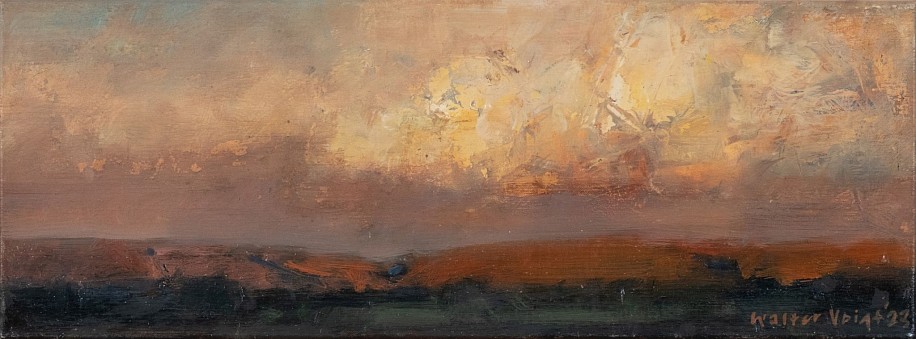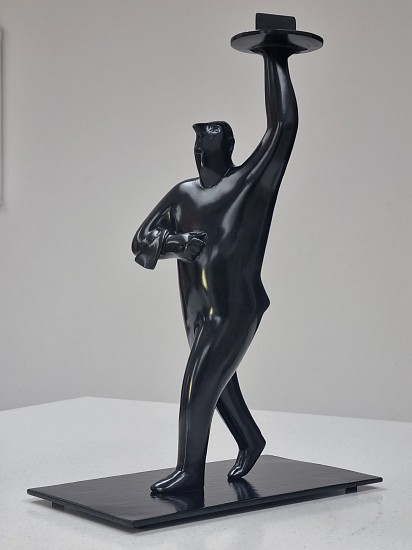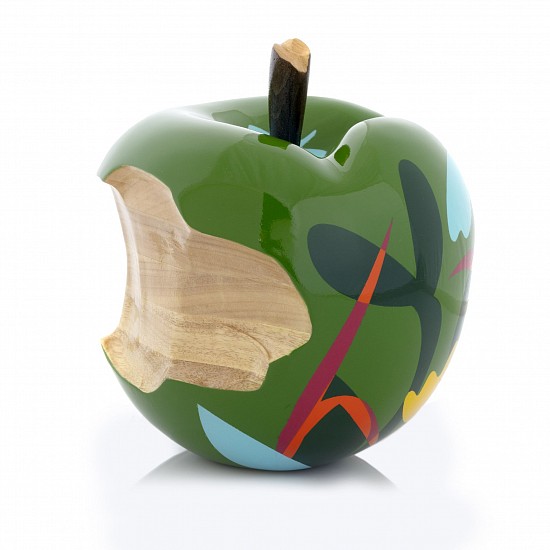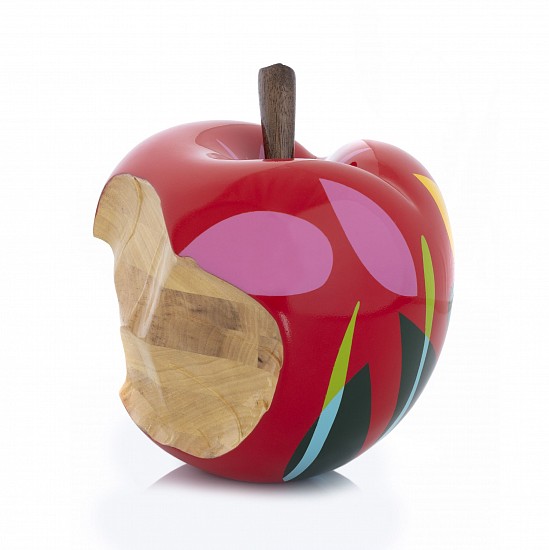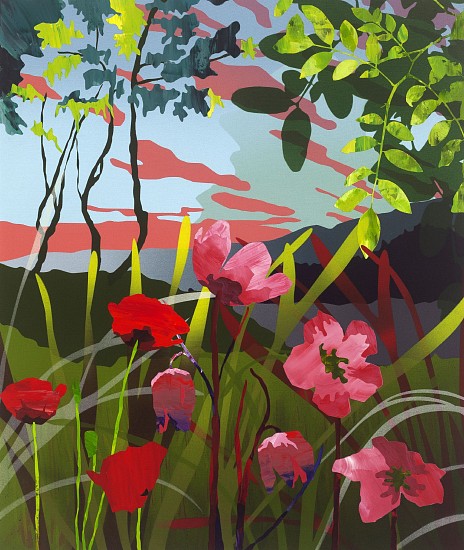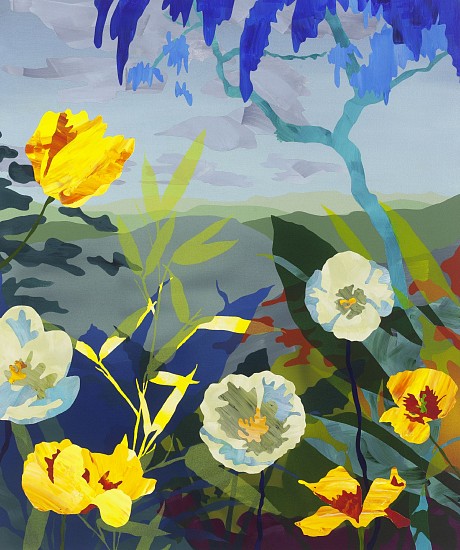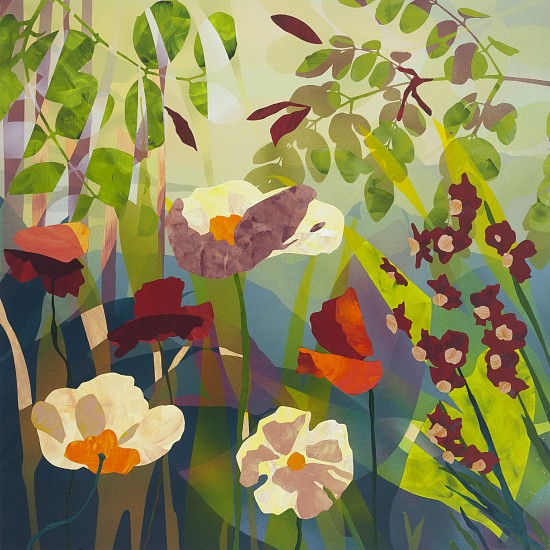SOUTHERN LIGHT | Group Exhibition




CATHY ABRAHAM, An orange splendour (6048 strokes)
oil on Italian cotton canvas, 144 x 100 cm
Cathy Abraham’s practice is deeply influenced by artists from the Korean Dansaekhwa movement, along with the repetitive incantations of artists such as Roman Opalka and Agnes Martin, among others. Abraham works systematically with repetitive gestures as a way of thinking through the patterns and experiences that mark our daily existence. The highly developed surfaces of her work consider boundaries between reality, fantasy and illusion. ‘I count brush marks as a form of meditation, allowing the mark of the brush to leave a visual trace as ghosts do. The ‘ghostings’ are composed from an overlapping series of brushmarks. At first laden with paint the brush begins to make its mark yet through the sequence of strokes, its colour diminishes until there is only an unstable, fragmented residue. I cannot be sure what residues haunt and inspire me, as there are so many events I would like to forget, yet I remain aware of these experiences and their after-effects. By repeatedly drawing or painting the seemingly same mark, I am hoping to find expression for the inexpressible, bringing into existence that which is intangible yet felt.’




CATHY ABRAHAM, Crown
Oil and gold leaf on Italian cotton canvas, 144 x 100 cm
Cathy Abraham’s practice is deeply influenced by artists from the Korean Dansaekhwa movement, along with the repetitive incantations of artists such as Roman Opalka and Agnes Martin, among others. Abraham works systematically with repetitive gestures as a way of thinking through the patterns and experiences that mark our daily existence. The highly developed surfaces of her work consider boundaries between reality, fantasy and illusion. ‘I count brush marks as a form of meditation, allowing the mark of the brush to leave a visual trace as ghosts do. The ‘ghostings’ are composed from an overlapping series of brushmarks. At first laden with paint the brush begins to make its mark yet through the sequence of strokes, its colour diminishes until there is only an unstable, fragmented residue. I cannot be sure what residues haunt and inspire me, as there are so many events I would like to forget, yet I remain aware of these experiences and their after-effects. By repeatedly drawing or painting the seemingly same mark, I am hoping to find expression for the inexpressible, bringing into existence that which is intangible yet felt.’



CATHY ABRAHAM, Golden spine II
oil on Italian cotton canvas, 144 x 100 cm
Cathy Abraham’s practice is deeply influenced by artists from the Korean Dansaekhwa movement, along with the repetitive incantations of artists such as Roman Opalka and Agnes Martin, among others. Abraham works systematically with repetitive gestures as a way of thinking through the patterns and experiences that mark our daily existence. The highly developed surfaces of her work consider boundaries between reality, fantasy and illusion. ‘I count brush marks as a form of meditation, allowing the mark of the brush to leave a visual trace as ghosts do. The ‘ghostings’ are composed from an overlapping series of brushmarks. At first laden with paint the brush begins to make its mark yet through the sequence of strokes, its colour diminishes until there is only an unstable, fragmented residue. I cannot be sure what residues haunt and inspire me, as there are so many events I would like to forget, yet I remain aware of these experiences and their after-effects. By repeatedly drawing or painting the seemingly same mark, I am hoping to find expression for the inexpressible, bringing into existence that which is intangible yet felt.’




CATHY ABRAHAM, Spectral bones VII
oil on Italian cotton canvas, 144 x 100 cm
Cathy Abraham’s practice is deeply influenced by artists from the Korean Dansaekhwa movement, along with the repetitive incantations of artists such as Roman Opalka and Agnes Martin, among others. Abraham works systematically with repetitive gestures as a way of thinking through the patterns and experiences that mark our daily existence. The highly developed surfaces of her work consider boundaries between reality, fantasy and illusion. ‘I count brush marks as a form of meditation, allowing the mark of the brush to leave a visual trace as ghosts do. The ‘ghostings’ are composed from an overlapping series of brushmarks. At first laden with paint the brush begins to make its mark yet through the sequence of strokes, its colour diminishes until there is only an unstable, fragmented residue. I cannot be sure what residues haunt and inspire me, as there are so many events I would like to forget, yet I remain aware of these experiences and their after-effects. By repeatedly drawing or painting the seemingly same mark, I am hoping to find expression for the inexpressible, bringing into existence that which is intangible yet felt.’



BEEZY BAILEY, Airplane King
Hand painted bronze, 40 x 90 x 6.5 cm
One of South Africa’s most colourful and celebrated artists, Beezy Bailey has exhibited internationally for nearly 40 years. He is a multi-disciplinary artist whose practice includes painting, sculpture, drawing, printmaking, and ceramics. Reflecting on the ideas and imagery for his work, in his own words he tells us, ‘frozen dreams, images and legends enter from my subconscious … the realm of my imagination. I act as a conduit for visual messages greater than I am.’ Figures in flight frequent Bailey’s work and pay homage to the generations before him; his father was an RAF pilot during the second world war, and his grandmother an outstanding female aviator who flew a pioneering solo flight from London to Cape Town and back in 1928. More generally, Bailey aspires to create art as a balm for a mad world – a corrective for our most lamentable human qualities, including a planet brutalized by extremes of wealth and poverty, environmental ignorance, and negligence. ‘For every degree of darkness in the world, there has to be an inverse degree of light, so that we can see it all. So it is light that I search for – light of the flame of humanity, light that has to shine out of my work.’


PHILIP BARLOW, billie
Oil on linen, 120 x 80 cm
Philip Barlow describes his work as a step towards abstraction. It is primarily the exploration of light and the relationship of colour, where he first captures his images with a camera and then translates them into a painted format. He is interested in the concept of capturing ‘the moment’, a millisecond in time when everything lines up perfectly. ‘Although I work within a long tradition of landscape painting, my depiction of the ‘seen’ landscape is simply a vehicle through which I navigate territory of another nature. A landscape less ordinary; where the line between the physical and the spiritual realm has seemingly been removed. However, these scenarios are not intended to be of a surreal nature. Hopefully they will seem curiously familiar and convincingly real.’



PHILIP BARLOW, glow IV
Oil on linen, 80 x 80 cm
Philip Barlow describes his work as a step towards abstraction. It is primarily the exploration of light and the relationship of colour, where he first captures his images with a camera and then translates them into a painted format. He is interested in the concept of capturing ‘the moment’, a millisecond in time when everything lines up perfectly. ‘Although I work within a long tradition of landscape painting, my depiction of the ‘seen’ landscape is simply a vehicle through which I navigate territory of another nature. A landscape less ordinary; where the line between the physical and the spiritual realm has seemingly been removed. However, these scenarios are not intended to be of a surreal nature. Hopefully they will seem curiously familiar and convincingly real.’


EMALIE BINGHAM, An Ordinary Day 02.09.23
Mixed media on paper, 42 x 29.7 cm
‘My work is centred around emerging and shifting patterns of transformation, connection, and possibility. Both technically and conceptually, I seek to deconstruct and subvert binary paradigms, towards an alternative narrative of fluidity, possibility, and inclusion. I create, collect, dismantle, and redesign marks as symbols, developing a system of abstract signs through form, material, and process. This particular visual alphabet consists of offcuts, incidental strokes, and more intentional, repetitive explorations of personally significant objects. The compositions impose a kind of visual ‘dyslexia’, requiring imaginative readings beyond familiar patterning of ‘language’, and so what each mark represents may depend on interpretation. The emergent abstract designs pose questions and open dialogue around notions of framing, visibility, belonging, transition, chaos, deviance, and perception.’


EMALIE BINGHAM, An Ordinary Day 12.08.23
Collage, 42 x 29.7 cm
‘My work is centred around emerging and shifting patterns of transformation, connection, and possibility. Both technically and conceptually, I seek to deconstruct and subvert binary paradigms, towards an alternative narrative of fluidity, possibility, and inclusion. I create, collect, dismantle, and redesign marks as symbols, developing a system of abstract signs through form, material, and process. This particular visual alphabet consists of offcuts, incidental strokes, and more intentional, repetitive explorations of personally significant objects. The compositions impose a kind of visual ‘dyslexia’, requiring imaginative readings beyond familiar patterning of ‘language’, and so what each mark represents may depend on interpretation. The emergent abstract designs pose questions and open dialogue around notions of framing, visibility, belonging, transition, chaos, deviance, and perception.’


EMALIE BINGHAM, An Ordinary Day 27.04.23
Collage, 42 x 29.7 cm
‘My work is centred around emerging and shifting patterns of transformation, connection, and possibility. Both technically and conceptually, I seek to deconstruct and subvert binary paradigms, towards an alternative narrative of fluidity, possibility, and inclusion. I create, collect, dismantle, and redesign marks as symbols, developing a system of abstract signs through form, material, and process. This particular visual alphabet consists of offcuts, incidental strokes, and more intentional, repetitive explorations of personally significant objects. The compositions impose a kind of visual ‘dyslexia’, requiring imaginative readings beyond familiar patterning of ‘language’, and so what each mark represents may depend on interpretation. The emergent abstract designs pose questions and open dialogue around notions of framing, visibility, belonging, transition, chaos, deviance, and perception.’
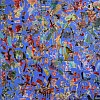


EMALIE BINGHAM, Foundation
Mixed media on canvas, 101.6 x 101.6 cm
Emalie Bingham was born in South Africa, where she trained as an artist and exhibited for ten years before relocating to the UK in 2019. This exposed her to a widened variety of sociopolitical, psychospiritual, and design perspectives within a new environment, further shaping and expanding her creative practice. Playfully juxtaposing, layering, and collaging marks as repeating motifs, Emalie Bingham’s mixed media work explores endless possible outcomes, and considers a re-writing of normative attitudes towards grouping, orientation, and order. ‘My work is centred around emerging and shifting patterns of transformation, connection, and possibility. Both technically and conceptually, I seek to deconstruct and subvert binary paradigms, towards an alternative narrative of fluidity, possibility, and inclusion. I create, collect, dismantle, and redesign marks as symbols, developing a system of abstract signs through form, material, and process. This particular visual alphabet consists of offcuts, incidental strokes, and more intentional, repetitive explorations of personally significant objects. The compositions impose a kind of visual ‘dyslexia’, requiring imaginative readings beyond familiar patterning of ‘language’, and so what each mark represents may depend on interpretation. The emergent abstract designs pose questions and open dialogue around notions of framing, visibility, belonging, transition, chaos, deviance, and perception.’


NIC BLADEN, Dovyalis Caffra (""Kei Apple""
Bronze on crystal base, 125 x 85 x 73 cm
Nic Bladen is regarded as one of the world’s finest botanical sculptors working today. Through
the alchemical process that transpires in his studio’s furnaces, he can produce delicate artistic
reconstructions of astoundingly beautiful flowering plants.
The precision and care that goes into casting and reconstructing lifelike replicas is immense, and Bladen has become a master of his craft. Central to Bladen’s mission is a desire to preserve the singular beauty of plants, and through his sculptures (all unique casts) the artist shines a light on the subtle and diverse beauty of the plants of his native Western Cape. We are more sensitized to their extraordinary beauty given the indications that their home is within a region that is profoundly affected by climate change.


ARABELLA CACCIA, Garden of Remembering I, 2023
embroidery and applique on linen, 37 x 104 cm
Arabella Caccia draws inspiration for her work from the people, places and objects around her. From the light where she lives and the wilderness where she goes to find peace and silence. The feeling of quiet and perhaps stillness in the work reflects the ambience she creates around her, in order to find inspiration and access her creativity. ‘I firmly believe that the energy and focus put into making a work, a deep meditative concentration,produces work of honesty and integrity, with a powerful energy. It is the process which is of utmost importance.’ The embroidery works presented in this exhibition are inspired by in the incredible landscapes Caccia saw on a recent road trip across Southern Africa, which included the sand dunes in Namibia, the Okavango Delta in Botswana, the Chilojo cliffs in Gonarezhou in Zimbabwe, the plains of Zambia, Lake Tanganyika, Lake Malawi and Mozambique.



ARABELLA CACCIA, Summer Flora (Blue), Zimbabwe, 2023
Embroidery on hand woven silk, 120 x 125 cm
Arabella Caccia draws inspiration for her work from the people, places and objects around her. From the light where she lives and the wilderness where she goes to find peace and silence. The feeling of quiet and perhaps stillness in the work reflects the ambience she creates around her, in order to find inspiration and access her creativity. ‘I firmly believe that the energy and focus put into making a work, a deep meditative concentration,produces work of honesty and integrity, with a powerful energy. It is the process which is of utmost importance.’ The embroidery works presented in this exhibition are inspired by in the incredible landscapes Caccia saw on a recent road trip across Southern Africa, which included the sand dunes in Namibia, the Okavango Delta in Botswana, the Chilojo cliffs in Gonarezhou in Zimbabwe, the plains of Zambia, Lake Tanganyika, Lake Malawi and Mozambique.



ARABELLA CACCIA, Woodland, Hwange, Zimbabwe. 2023
Embroidery & applique on silk, 56 x 106 cm
Arabella Caccia draws inspiration for her work from the people, places and objects around her. From the light where she lives and the wilderness where she goes to find peace and silence. The feeling of quiet and perhaps stillness in the work reflects the ambience she creates around her, in order to find inspiration and access her creativity. ‘I firmly believe that the energy and focus put into making a work, a deep meditative concentration,produces work of honesty and integrity, with a powerful energy. It is the process which is of utmost importance.’ The embroidery works presented in this exhibition are inspired by in the incredible landscapes Caccia saw on a recent road trip across Southern Africa, which included the sand dunes in Namibia, the Okavango Delta in Botswana, the Chilojo cliffs in Gonarezhou in Zimbabwe, the plains of Zambia, Lake Tanganyika, Lake Malawi and Mozambique.





ERIN CHAPLIN, Brown Flower
Oil on canvas, 21 x 15 cm
‘I feel like I am living between worlds. Reality, fantasy and my own reality. And time is ticking on in the background. Still life resonates with me because it’s on the clock too. Flowers and fruit can be arranged and painted to live forever but they will die and rot. This comforts me. I don’t want anything to be too perfect or too alive because that’s not realistic.’ Erin Chaplin studies the relationship between the natural and the artificial in her work, striving to capture the poignancy of youth as it fades – fresh fruit and flowers as they slowly rot. In response to the challenging nature of the genre, the floral still-life works are executed in a combination of muted tones and unexpected, contrived colours. The contrast of these tones creates a dynamism in the work that entices and surprises the viewer. In her impasto paintings, a metaphor grows to encapsulate the delicate rawness and vulnerability of the human condition as we grapple with life as it unfolds.


ERIN CHAPLIN, Butterfly
Embroidery on fabric, 22 x 17.5 cm
‘I feel like I am living between worlds. Reality, fantasy and my own reality. And time is ticking on in the background. Still life resonates with me because it’s on the clock too. Flowers and fruit can be arranged and painted to live forever but they will die and rot. This comforts me. I don’t want anything to be too perfect or too alive because that’s not realistic.’ Erin Chaplin studies the relationship between the natural and the artificial in her work, striving to capture the poignancy of youth as it fades – fresh fruit and flowers as they slowly rot. In response to the challenging nature of the genre, the floral still-life works are executed in a combination of muted tones and unexpected, contrived colours. The contrast of these tones creates a dynamism in the work that entices and surprises the viewer. In her impasto paintings, a metaphor grows to encapsulate the delicate rawness and vulnerability of the human condition as we grapple with life as it unfolds.





ERIN CHAPLIN, Caterpillar
Oil on canvas, 20.5 x 15.5 cm
‘I feel like I am living between worlds. Reality, fantasy and my own reality. And time is ticking on in the background. Still life resonates with me because it’s on the clock too. Flowers and fruit can be arranged and painted to live forever but they will die and rot. This comforts me. I don’t want anything to be too perfect or too alive because that’s not realistic.’ Erin Chaplin studies the relationship between the natural and the artificial in her work, striving to capture the poignancy of youth as it fades – fresh fruit and flowers as they slowly rot. In response to the challenging nature of the genre, the floral still-life works are executed in a combination of muted tones and unexpected, contrived colours. The contrast of these tones creates a dynamism in the work that entices and surprises the viewer. In her impasto paintings, a metaphor grows to encapsulate the delicate rawness and vulnerability of the human condition as we grapple with life as it unfolds.



ERIN CHAPLIN, Field (brown grass)
Oil on canvas, 73 x 62 cm
‘I feel like I am living between worlds. Reality, fantasy and my own reality. And time is ticking on in the background. Still life resonates with me because it’s on the clock too. Flowers and fruit can be arranged and painted to live forever but they will die and rot. This comforts me. I don’t want anything to be too perfect or too alive because that’s not realistic.’ Erin Chaplin studies the relationship between the natural and the artificial in her work, striving to capture the poignancy of youth as it fades – fresh fruit and flowers as they slowly rot. In response to the challenging nature of the genre, the floral still-life works are executed in a combination of muted tones and unexpected, contrived colours. The contrast of these tones creates a dynamism in the work that entices and surprises the viewer. In her impasto paintings, a metaphor grows to encapsulate the delicate rawness and vulnerability of the human condition as we grapple with life as it unfolds.


ERIN CHAPLIN, Field (with blue)
Oil on canvas, 74 x 70 cm
‘I feel like I am living between worlds. Reality, fantasy and my own reality. And time is ticking on in the background. Still life resonates with me because it’s on the clock too. Flowers and fruit can be arranged and painted to live forever but they will die and rot. This comforts me. I don’t want anything to be too perfect or too alive because that’s not realistic.’ Erin Chaplin studies the relationship between the natural and the artificial in her work, striving to capture the poignancy of youth as it fades – fresh fruit and flowers as they slowly rot. In response to the challenging nature of the genre, the floral still-life works are executed in a combination of muted tones and unexpected, contrived colours. The contrast of these tones creates a dynamism in the work that entices and surprises the viewer. In her impasto paintings, a metaphor grows to encapsulate the delicate rawness and vulnerability of the human condition as we grapple with life as it unfolds.



ERIN CHAPLIN, Golden Boy
Embroidery on fabric, 22.5 x 18 cm
‘I feel like I am living between worlds. Reality, fantasy and my own reality. And time is ticking on in the background. Still life resonates with me because it’s on the clock too. Flowers and fruit can be arranged and painted to live forever but they will die and rot. This comforts me. I don’t want anything to be too perfect or too alive because that’s not realistic.’ Erin Chaplin studies the relationship between the natural and the artificial in her work, striving to capture the poignancy of youth as it fades – fresh fruit and flowers as they slowly rot. In response to the challenging nature of the genre, the floral still-life works are executed in a combination of muted tones and unexpected, contrived colours. The contrast of these tones creates a dynamism in the work that entices and surprises the viewer. In her impasto paintings, a metaphor grows to encapsulate the delicate rawness and vulnerability of the human condition as we grapple with life as it unfolds.


ERIN CHAPLIN, Merry Land
Embroidery on fabric, 22.5 x 16 cm
‘I feel like I am living between worlds. Reality, fantasy and my own reality. And time is ticking on in the background. Still life resonates with me because it’s on the clock too. Flowers and fruit can be arranged and painted to live forever but they will die and rot. This comforts me. I don’t want anything to be too perfect or too alive because that’s not realistic.’ Erin Chaplin studies the relationship between the natural and the artificial in her work, striving to capture the poignancy of youth as it fades – fresh fruit and flowers as they slowly rot. In response to the challenging nature of the genre, the floral still-life works are executed in a combination of muted tones and unexpected, contrived colours. The contrast of these tones creates a dynamism in the work that entices and surprises the viewer. In her impasto paintings, a metaphor grows to encapsulate the delicate rawness and vulnerability of the human condition as we grapple with life as it unfolds.




ERIN CHAPLIN, You Ghost
Oil on canvas, 22 x 17 cm
‘I feel like I am living between worlds. Reality, fantasy and my own reality. And time is ticking on in the background. Still life resonates with me because it’s on the clock too. Flowers and fruit can be arranged and painted to live forever but they will die and rot. This comforts me. I don’t want anything to be too perfect or too alive because that’s not realistic.’ Erin Chaplin studies the relationship between the natural and the artificial in her work, striving to capture the poignancy of youth as it fades – fresh fruit and flowers as they slowly rot. In response to the challenging nature of the genre, the floral still-life works are executed in a combination of muted tones and unexpected, contrived colours. The contrast of these tones creates a dynamism in the work that entices and surprises the viewer. In her impasto paintings, a metaphor grows to encapsulate the delicate rawness and vulnerability of the human condition as we grapple with life as it unfolds.



WILMA CRUISE, Kom Sit
Bronze and concrete, 95 x 150 x 85 cm
Wilma Cruise is a multi-disciplinary artist, whose work predominantly explores the interface between humans and animals, and existential conditions of muteness; silent, internal battles in the search for meaning. ‘I like to invert the Cartesian question which is not can they talk, but can we listen. The whole drive for me with these works is to equate animal beings with human beings without anthropomorphising them. Anthropomorphising is the ultimate danger when you work with images of animals. I want people to feel what the animal is feeling without making the animal human, or a metaphor, or a cipher for human. It must be in itself, of it itself, that animal.’




RICKY DYALOYI, As we wait expectantly I
Mixed media on canvas, 150 x 100 cm
Ricky Dyaloyi’s paintings astutely and tenderly record the life of his surrounding community. He captures the energy of crowds and a vivid sense of the individuals within those multitudes, with their distinctive posture and demeanour, expressed with the most minimal of gestures. In his renderings of his fellow South Africans – ordinary citizens going about their daily lives – Dyaloyi gives us insight into their hopes, dreams, fears and longings – what it is to be human. His work reflects the artist’s deep empathy with humanity and encourages us to single out fellow humans in the crowd; to experience our own empathy.



LUCA EVANS, CRASH, /kɹæʃ/, 2023
african rosewood, birch, kiaat, maple, sapele and walnut on pine, 31 x 49 x 2 cm
Luca Evans is a Cape Town based artist, working primarily with wood, and text. Their work sits in a playful and delicate intersection between tradition and alteration, linguistics and visual art. Sometimes they place the viewer in the position of a phonetician, a branch of linguistics which studies how humans produce and perceive sounds. ‘How do you write sound? How do you signify it? Text and sound bump into each other and spill out. Words work hard. They signify meanings and ideas and actions all at once. Sound words work hard too; it’s not easy signifying sound. Our lexicons are filled with onomatopoeia. Chomp, hiccough, beep, fizz, splash, pop, honk, crack, thud, oomph. I used to work in linguistics. We transcribed sound, rendering it legible. They made an international alphabet of sounds. k/ ræ∫ bæŋ pft. So I started wondering if maybe objects can be sounds. See a mousetrap and hear a snap. This room is filled with sounds. It’s a cacophony, but your head has to fill in the sounds.’



LUCA EVANS, VROOOOM /vɹʊm/, 2023
african rosewood, birch, kiaat, maple, sapele and walnut on pine, 21 x 28.5 x 2 cm
Luca Evans is a Cape Town based artist, working primarily with wood, and text. Their work sits in a playful and delicate intersection between tradition and alteration, linguistics and visual art. Sometimes they place the viewer in the position of a phonetician, a branch of linguistics which studies how humans produce and perceive sounds. ‘How do you write sound? How do you signify it? Text and sound bump into each other and spill out. Words work hard. They signify meanings and ideas and actions all at once. Sound words work hard too; it’s not easy signifying sound. Our lexicons are filled with onomatopoeia. Chomp, hiccough, beep, fizz, splash, pop, honk, crack, thud, oomph. I used to work in linguistics. We transcribed sound, rendering it legible. They made an international alphabet of sounds. k/ ræ∫ bæŋ pft. So I started wondering if maybe objects can be sounds. See a mousetrap and hear a snap. This room is filled with sounds. It’s a cacophony, but your head has to fill in the sounds.’



MATTHEW HINDLEY, A Final Look at the Picture
Oil on canvas, 98 x 130 cm
Matthew Hindley’s artistic focus has grown and developed over the years, from portraiture to abstraction and now the exploration of the landscape. A residency at the gardens and wetlands of Leeu Estates in Franschhoek provided the landscape muse for this new direction, and Hindley continued the series, exploring landscapes of personal significance to him: the view from his former studio, the road where he now lives, the forest he and his daughter visited on holiday. Hindley refers to these works as Memoryscapes – the scenes are laden with his personal memories as well as the significance assigned to them from the wider communities who treasure and protect the important places of outstanding natural beauty. Vibrant, luminous and teeming with life the paintings do not claim ownership of the landscapes but rather proclaim an intense love for their subjects.




MATTHEW HINDLEY, Infinite Mortality (The Wetlands)
Oil on canvas, 130 x 97 cm
Matthew Hindley’s artistic focus has grown and developed over the years, from portraiture to abstraction and now the exploration of the landscape. A residency at the gardens and wetlands of Leeu Estates in Franschhoek provided the landscape muse for this new direction, and Hindley continued the series, exploring landscapes of personal significance to him: the view from his former studio, the road where he now lives, the forest he and his daughter visited on holiday. Hindley refers to these works as Memoryscapes – the scenes are laden with his personal memories as well as the significance assigned to them from the wider communities who treasure and protect the important places of outstanding natural beauty. Vibrant, luminous and teeming with life the paintings do not claim ownership of the landscapes but rather proclaim an intense love for their subjects.






JEANNE HOFFMAN, A Vibration of Everyday Things
acrylic on cotton, 100 x 80 cm
Working across diverse mediums and far-flung geographies, artist Jeanne Hoffman revels
in the spaces between things.
Paintings, drawings and ceramic objects function as dwelling
points – ‘temporary shelters for thoughts’ – as she explores the emotional and socio-cultural
dimensions of place. Hoffman says: ‘There is a direct correlation between travelling across a
landscape and the path of a graphic mark that transforms a blank page into an imaginary
space.’ ‘Drawing’ translates then not only to three-dimensional artistic mediums and physical
space, but also to a larger ‘stage’: Referential forms are assembled in relation with one
another, creating movement, dialogue and meaning on the fringes of delineation.


JEANNE HOFFMAN, Outside Coming In
acrylic on cotton, 100 x 80 cm
Working across diverse mediums and far-flung geographies, artist Jeanne Hoffman revels in the spaces between things. Paintings, drawings and ceramic objects function as dwelling points – ‘temporary shelters for thoughts’ – as she explores the emotional and socio-cultural dimensions of place. Hoffman says: ‘There is a direct correlation between travelling across a landscape and the path of a graphic mark that transforms a blank page into an imaginary space.’ ‘Drawing’ translates then not only to three-dimensional artistic mediums and physical space, but also to a larger ‘stage’: Referential forms are assembled in relation with one another, creating movement, dialogue and meaning on the fringes of delineation.


KILMANY-JO LIVERSAGE, CAESURA
acrylic, aerosol spray and marker on canvas, 120 x 120 cm
‘I feel strongly about the role women play in our society and am interested in portraying the strength and Femme fatalism of women in my portraits and still-lives. The role of matriarch has gained impetus through the digital age. Empowerment, transformation and a greater emphasis on gender-equality has created a global shift in how femininity is perceived and how contemporary women are portrayed.’ Kilmany-Jo Liversage creates portraits that intentionally blur the boundary between fine art and street art. Her rendering of female subjects is inspired by Renaissance-era portraiture and, by adopting the language of graffiti or urban art, she updates, renews and challenges the conventions of painting. Her work also references digitised mass production and a futuristic post-human world, populated by perfect-looking female cyborgs. The result is a series of vivid, large-format paintings, evoking the street, art history as well as a vision of the future.



KILMANY-JO LIVERSAGE, EMVA
acrylic, aerosol spray and marker on 300g Fabriano archival paper, 76 x 56 cm
‘I feel strongly about the role women play in our society and am interested in portraying the strength and Femme fatalism of women in my portraits and still-lives. The role of matriarch has gained impetus through the digital age. Empowerment, transformation and a greater emphasis on gender-equality has created a global shift in how femininity is perceived and how contemporary women are portrayed.’ Kilmany-Jo Liversage creates portraits that intentionally blur the boundary between fine art and street art. Her rendering of female subjects is inspired by Renaissance-era portraiture and, by adopting the language of graffiti or urban art, she updates, renews and challenges the conventions of painting. Her work also references digitised mass production and a futuristic post-human world, populated by perfect-looking female cyborgs. The result is a series of vivid, large-format paintings, evoking the street, art history as well as a vision of the future.



ANNA MALVISI WHITE, Capulet
Bronze, 14 x 74 x 7 cm
Anna Malvisi White spent most of her childhood holidays in the British museum sketching the toga draped Romans, muscular Greek Gods and stylised ancient Egyptian carvings – gaining an appreciation for the art of sculpting and a desire to learn the skills. In the mid-80s she enrolled in a life drawing and clay modelling class in London where she was taught to study the shape and volume of every bone, muscle, and sinew of the human body. While studying she tried stone carving, learning the skills that she still implements in her work today.


ANNA MALVISI WHITE, Chyka
Bronze on brass sheet base, 40.5 x 40 x 12 cm
Anna Malvisi White spent most of her childhood holidays in the British museum sketching the toga draped Romans, muscular Greek Gods and stylised ancient Egyptian carvings – gaining an appreciation for the art of sculpting and a desire to learn the skills. In the mid-80s she enrolled in a life drawing and clay modelling class in London where she was taught to study the shape and volume of every bone, muscle, and sinew of the human body. While studying she tried stone carving, learning the skills that she still implements in her work today.



ANNA MALVISI WHITE, Dove - Looking Down
Bronze, 54 x 20 x 20 cm
Anna Malvisi White spent most of her childhood holidays in the British museum sketching the toga draped Romans, muscular Greek Gods and stylised ancient Egyptian carvings – gaining an appreciation for the art of sculpting and a desire to learn the skills. In the mid-80s she enrolled in a life drawing and clay modelling class in London where she was taught to study the shape and volume of every bone, muscle, and sinew of the human body. While studying she tried stone carving, learning the skills that she still implements in her work today.



ANNA MALVISI WHITE, Dove - Looking Up
Bronze, 31.5 x 23 x 23 cm
Anna Malvisi White spent most of her childhood holidays in the British museum sketching the toga draped Romans, muscular Greek Gods and stylised ancient Egyptian carvings – gaining an appreciation for the art of sculpting and a desire to learn the skills. In the mid-80s she enrolled in a life drawing and clay modelling class in London where she was taught to study the shape and volume of every bone, muscle, and sinew of the human body. While studying she tried stone carving, learning the skills that she still implements in her work today.


ANNA MALVISI WHITE, Glissando
Bronze, 75 x 7.5 x 12.5 cm
Anna Malvisi White spent most of her childhood holidays in the British museum sketching the toga draped Romans, muscular Greek Gods and stylised ancient Egyptian carvings – gaining an appreciation for the art of sculpting and a desire to learn the skills. In the mid-80s she enrolled in a life drawing and clay modelling class in London where she was taught to study the shape and volume of every bone, muscle, and sinew of the human body. While studying she tried stone carving, learning the skills that she still implements in her work today.



ANNA MALVISI WHITE, Mermaid
Bronze, 26 x 30.5 x 20 cm
Anna Malvisi White spent most of her childhood holidays in the British museum sketching the toga draped Romans, muscular Greek Gods and stylised ancient Egyptian carvings – gaining an appreciation for the art of sculpting and a desire to learn the skills. In the mid-80s she enrolled in a life drawing and clay modelling class in London where she was taught to study the shape and volume of every bone, muscle, and sinew of the human body. While studying she tried stone carving, learning the skills that she still implements in her work today.



GERHARD MARX, Dwelling Drawing I
plant material and acrylic ground on canvas and board, 70 x 90 cm
Gerhard Marx’s poetic and philosophical visual language is composed through a physical engagement with distinctive material traditions. His process entails careful acts of dissection and rearrangement, which allow Marx to engage the poetic potential and philosophical assumptions of his chosen material in the process of developing original drawing, sculptural and performative languages. A primary focus in his work engages physical depictions of space – ‘spatial imaginaries’ – with an interest in how these descriptions of space affect and shape that which it describes. Marx uses acts of fragmentation and reassembly to construct alternate and deliberately complicated spatial propositions that aspire to hold multiple positionalities, doubled presences, folded histories, spaces that exist across, in between, and amongst.



GERHARD MARX, Dwelling Drawing II
plant material and acrylic ground on canvas and board, 70 x 90 cm
Gerhard Marx’s poetic and philosophical visual language is composed through a physical engagement with distinctive material traditions. His process entails careful acts of dissection and rearrangement, which allow Marx to engage the poetic potential and philosophical assumptions of his chosen material in the process of developing original drawing, sculptural and performative languages. A primary focus in his work engages physical depictions of space – ‘spatial imaginaries’ – with an interest in how these descriptions of space affect and shape that which it describes. Marx uses acts of fragmentation and reassembly to construct alternate and deliberately complicated spatial propositions that aspire to hold multiple positionalities, doubled presences, folded histories, spaces that exist across, in between, and amongst.


JOHN MURRAY, Foundation
Acrylic on canvas, 80 x 60 cm
John Murray is a South African painter living and working in Cape Town. Finding significance in the contrasting states between the tangible and the imperceptible, playfulness and seriousness, Murray moves between representational and nonrepresentational forms. Working in oil on canvas as well as in collage and bricolage, the images used in his compositions are often interpretations of found objects and photographs. Some of these images have specific cultural, historical or political significance, while others are trivia collected from the artist’s everyday surroundings. These composite images or compositions prompt viewer specific responses and associations, with the juxtaposition of images acting as triggers or catalysts for meaning. More recently Murray’s work has leaned towards abstraction, not in its purest sense but rendered in a way that still hints at representational forms beneath the surface. These works originally inspired by the different colours and hues that accumulated on the artists mixing pallets while working have evolved in to an ongoing series of paintings that allude structures that are simultaneously in the process of forming or perhaps disintegrating.



JOHN MURRAY, Left Behind
Acrylic on canvas, 60 x 45 cm
John Murray is a South African painter living and working in Cape Town. Finding significance in the contrasting states between the tangible and the imperceptible, playfulness and seriousness, Murray moves between representational and nonrepresentational forms. Working in oil on canvas as well as in collage and bricolage, the images used in his compositions are often interpretations of found objects and photographs. Some of these images have specific cultural, historical or political significance, while others are trivia collected from the artist’s everyday surroundings. These composite images or compositions prompt viewer specific responses and associations, with the juxtaposition of images acting as triggers or catalysts for meaning. More recently Murray’s work has leaned towards abstraction, not in its purest sense but rendered in a way that still hints at representational forms beneath the surface. These works originally inspired by the different colours and hues that accumulated on the artists mixing pallets while working have evolved in to an ongoing series of paintings that allude structures that are simultaneously in the process of forming or perhaps disintegrating.




JOHN MURRAY, Meander
acrylic on wood blocks and canvas, 69 x 58 cm
John Murray is a South African painter living and working in Cape Town. Finding significance in the contrasting states between the tangible and the imperceptible, playfulness and seriousness, Murray moves between representational and nonrepresentational forms. Working in oil on canvas as well as in collage and bricolage, the images used in his compositions are often interpretations of found objects and photographs. Some of these images have specific cultural, historical or political significance, while others are trivia collected from the artist’s everyday surroundings. These composite images or compositions prompt viewer specific responses and associations, with the juxtaposition of images acting as triggers or catalysts for meaning. More recently Murray’s work has leaned towards abstraction, not in its purest sense but rendered in a way that still hints at representational forms beneath the surface. These works originally inspired by the different colours and hues that accumulated on the artists mixing pallets while working have evolved in to an ongoing series of paintings that allude structures that are simultaneously in the process of forming or perhaps disintegrating.



JOHN MURRAY, Mutate
Acrylic on canvas, 80 x 60 cm
John Murray is a South African painter living and working in Cape Town. Finding significance in the contrasting states between the tangible and the imperceptible, playfulness and seriousness, Murray moves between representational and nonrepresentational forms. Working in oil on canvas as well as in collage and bricolage, the images used in his compositions are often interpretations of found objects and photographs. Some of these images have specific cultural, historical or political significance, while others are trivia collected from the artist’s everyday surroundings. These composite images or compositions prompt viewer specific responses and associations, with the juxtaposition of images acting as triggers or catalysts for meaning. More recently Murray’s work has leaned towards abstraction, not in its purest sense but rendered in a way that still hints at representational forms beneath the surface. These works originally inspired by the different colours and hues that accumulated on the artists mixing pallets while working have evolved in to an ongoing series of paintings that allude structures that are simultaneously in the process of forming or perhaps disintegrating.



MARK RAUTENBACH, Golden (Ad Hominem Series)
Mixed media, 130 x 130 cm
Mark Rautenbach is a Cape Town based artist who works in a variety of media, often with material which is considered waste matter, as well as textiles and paper. Rautenbach’s practice is often process-based, and draws on traditional craft techniques. Rautenbach was a university lecturer in design for many years, and education recurs as a theme in his work, along with identities born out of narratives, represented through yarn.




MARK RAUTENBACH, Redden (Ad Hominem Series)
Mixed media, 130 x 130 cm
Mark Rautenbach is a Cape Town based artist who works in a variety of media, often with material which is considered waste matter, as well as textiles and paper. Rautenbach’s practice is often process-based, and draws on traditional craft techniques. Rautenbach was a university lecturer in design for many years, and education recurs as a theme in his work, along with identities born out of narratives, represented through yarn.




GARY STEPHENS, Afternoon Light on Graaff-Reinet Aloes
Charcoal and newsprint collage on pleated paper, 114 x 140 cm
Gary Stephens’ landscapes pay homage to Africa and focus attention on symbols of African life.
In 2009 he undertook a year-long residency at Greatmore Studios in Cape Town. Since then
Stephens has been living and working in South Africa – where his work began on a series of
monumental portraits of his artist friends and their African sense of style and dress. With an
outsider eye and fresh appreciation of his adopted home, he combines his interests in optical
effects, stripes, and fractured images, with his love of pattern and mark-making, and uses the
portrait and landscape to explore both his visual interests and to engage with the beauty of
the African continent.
Graaff-Reinet is a town in the Karoo (Eastern Cape Province of South Africa). Was established by the Dutch East India Company in 1786 (after Cape Town in 1652 & Stellenbosch in 1679). The town is named after then-governor of the Cape Colony, Cornelis Jacob van de Graaff, and his wife Reynet. The town was originally established as a trading post to expand trading inland from the Cape Colony.




GARY STEPHENS, Red Swallows over Verwater Pan Acacia
Charcoal and newsprint collage on pleated paper, 114 x 170 cm
Gary Stephens’ landscapes pay homage to Africa and focus attention on symbols of African life. In 2009 he undertook a year-long residency at Greatmore Studios in Cape Town. Since then Stephens has been living and working in South Africa – where his work began on a series of monumental portraits of his artist friends and their African sense of style and dress. With an outsider eye and fresh appreciation of his adopted home, he combines his interests in optical effects, stripes, and fractured images, with his love of pattern and mark-making, and uses the portrait and landscape to explore both his visual interests and to engage with the beauty of the African continent.


ATANG TSHIKARE, Setlhare I
Wood, 50 x 33 x 30 cm
Atang Tshikare is a Cape Town-based, self-taught multidisciplinary artist. Tshikare was influenced from a young age by the visual storytelling and graphic style of his father, an anti-Apartheid activist and illustrator for various pan-African publications and art magazines. Through his practice, Tshikare expresses his distinct, visionary African identity through a unique visual language, developed over his career. Over the last twenty years, his practice has evolved from street art and drawings to limited edition collectible design, intersecting sculptural furniture and functional art, moving more recently to three-dimensional visual art. Drawing on a deep connection to his own Tswana heritage and other southern African cultures, Tshikare’s experimental approach to creating work includes various mediums, such as bronze, ceramics, glass, stone, and wood. His work takes inspiration from his fascination with zoomorphic shapes, biomorphic forms, vernacular architecture, and local landscapes. Each form strikes up a dialogue between natural and manmade materials that are organic, minimalistic and invite tactile curiosity.


ATANG TSHIKARE, Setlhare II
Wood, 51 x 31 x 25 cm
Atang Tshikare is a Cape Town-based, self-taught multidisciplinary artist. Tshikare was influenced from a young age by the visual storytelling and graphic style of his father, an anti-Apartheid activist and illustrator for various pan-African publications and art magazines. Through his practice, Tshikare expresses his distinct, visionary African identity through a unique visual language, developed over his career. Over the last twenty years, his practice has evolved from street art and drawings to limited edition collectible design, intersecting sculptural furniture and functional art, moving more recently to three-dimensional visual art. Drawing on a deep connection to his own Tswana heritage and other southern African cultures, Tshikare’s experimental approach to creating work includes various mediums, such as bronze, ceramics, glass, stone, and wood. His work takes inspiration from his fascination with zoomorphic shapes, biomorphic forms, vernacular architecture, and local landscapes. Each form strikes up a dialogue between natural and manmade materials that are organic, minimalistic and invite tactile curiosity.


ATANG TSHIKARE, Setlhare III
Wood, 35 x 28 x 17 cm
Atang Tshikare is a Cape Town-based, self-taught multidisciplinary artist. Tshikare was influenced from a young age by the visual storytelling and graphic style of his father, an anti-Apartheid activist and illustrator for various pan-African publications and art magazines. Through his practice, Tshikare expresses his distinct, visionary African identity through a unique visual language, developed over his career. Over the last twenty years, his practice has evolved from street art and drawings to limited edition collectible design, intersecting sculptural furniture and functional art, moving more recently to three-dimensional visual art. Drawing on a deep connection to his own Tswana heritage and other southern African cultures, Tshikare’s experimental approach to creating work includes various mediums, such as bronze, ceramics, glass, stone, and wood. His work takes inspiration from his fascination with zoomorphic shapes, biomorphic forms, vernacular architecture, and local landscapes. Each form strikes up a dialogue between natural and manmade materials that are organic, minimalistic and invite tactile curiosity.


ATANG TSHIKARE, Setlhare IV
Wood, 23 x 22 x 16 cm
Atang Tshikare is a Cape Town-based, self-taught multidisciplinary artist. Tshikare was influenced from a young age by the visual storytelling and graphic style of his father, an anti-Apartheid activist and illustrator for various pan-African publications and art magazines. Through his practice, Tshikare expresses his distinct, visionary African identity through a unique visual language, developed over his career. Over the last twenty years, his practice has evolved from street art and drawings to limited edition collectible design, intersecting sculptural furniture and functional art, moving more recently to three-dimensional visual art. Drawing on a deep connection to his own Tswana heritage and other southern African cultures, Tshikare’s experimental approach to creating work includes various mediums, such as bronze, ceramics, glass, stone, and wood. His work takes inspiration from his fascination with zoomorphic shapes, biomorphic forms, vernacular architecture, and local landscapes. Each form strikes up a dialogue between natural and manmade materials that are organic, minimalistic and invite tactile curiosity.


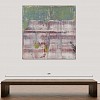
PHILIPPE UZAC, The Wall
Oil on canvas, 150 x 150 cm
‘Texture and patina are important elements in my work. But more essentially the laying bare of the past – looking for something like an unreachable truth – uncovering hidden layers of paint, is what drives me as an artist. I look for an aesthetic in decay and try to capture it on canvas and on wood panels that I use as support to my work. I reproduce the effects of time using all sorts of tools such as knives and spatulas, but also chemicals and waxes, sandpaper and glue. It is a gruelling and a very physical exercise, constantly scratching, rubbing and sanding off layers of paint. My work is abstract in essence, each piece being an object in itself. I work under the urge of bringing together interacting elements – a kind of vital incubation – producing eventually an epiphany of forms, textures and colours.’


SHANY VAN DEN BERG, Flowers
oil on French linen, 45 x 50 cm
Shany van den Berg is renowned for her technical acumen, subtle symbolism and agility in shifting between portraiture, figurative, abstraction and sculptural work. Van den Berg’s ethereal oil paintings evoke the mood and texture of Old Master paintings, conveying complex emotions, moods and ideas through meticulous attention to detail, an extraordinary facility with paint and subtle symbolism. A sense of layering pervades her works, in the imagery itself and through Van den Berg’s painterly process. Surfaces are built up of swathes, not painted onto the board but rather, absorbed into it. She explores contemporary themes of womanhood, identity, family, the natural world and connectedness to Mother Earth.



WALTER VOIGT, Sunrise Plains Study, Tswalu
Oil on canvas, 15 x 41 cm
The son of artist parents, Walter Voigt’s technical ability, coupled with a passion for sky and landscape, enables him to evoke the elements of light, space, air and movement. His atmospheric paintings invite contemplation and act as visual meditations on colour, light and form. Voigt’s paintings are constructed with broad, energetic strokes and there is a vigorous, scratchy quality to his work, achieved with a palette knife and oil bar, in addition to the brush. ‘The Turneresque views project a very emotive content upon the landscape. The quality of light and the juxtaposition with dark becomes a metaphor for broader, more ethereal concepts … The works become a pantheistic representation, almost having a spiritual residue encapsulating the place. This is not an attempt to record the landscape but rather an effort to allow the viewer to experience the particular light that is unique to the southern parts of Africa.’



WALTER VOIGT, Tswalu Cloud Study I
Oil on canvas, 15 x 41 cm
The son of artist parents, Walter Voigt’s technical ability, coupled with a passion for sky and landscape, enables him to evoke the elements of light, space, air and movement. His atmospheric paintings invite contemplation and act as visual meditations on colour, light and form. Voigt’s paintings are constructed with broad, energetic strokes and there is a vigorous, scratchy quality to his work, achieved with a palette knife and oil bar, in addition to the brush. ‘The Turneresque views project a very emotive content upon the landscape. The quality of light and the juxtaposition with dark becomes a metaphor for broader, more ethereal concepts … The works become a pantheistic representation, almost having a spiritual residue encapsulating the place. This is not an attempt to record the landscape but rather an effort to allow the viewer to experience the particular light that is unique to the southern parts of Africa.’



WALTER VOIGT, Tswalu Cloud Study II
Oil on canvas, 15 x 36 cm
The son of artist parents, Walter Voigt’s technical ability, coupled with a passion for sky and landscape, enables him to evoke the elements of light, space, air and movement. His atmospheric paintings invite contemplation and act as visual meditations on colour, light and form. Voigt’s paintings are constructed with broad, energetic strokes and there is a vigorous, scratchy quality to his work, achieved with a palette knife and oil bar, in addition to the brush. ‘The Turneresque views project a very emotive content upon the landscape. The quality of light and the juxtaposition with dark becomes a metaphor for broader, more ethereal concepts … The works become a pantheistic representation, almost having a spiritual residue encapsulating the place. This is not an attempt to record the landscape but rather an effort to allow the viewer to experience the particular light that is unique to the southern parts of Africa.’



WALTER VOIGT, Tswalu Cloud Study III
Oil on canvas, 15 x 36 cm
The son of artist parents, Walter Voigt’s technical ability, coupled with a passion for sky and landscape, enables him to evoke the elements of light, space, air and movement. His atmospheric paintings invite contemplation and act as visual meditations on colour, light and form. Voigt’s paintings are constructed with broad, energetic strokes and there is a vigorous, scratchy quality to his work, achieved with a palette knife and oil bar, in addition to the brush. ‘The Turneresque views project a very emotive content upon the landscape. The quality of light and the juxtaposition with dark becomes a metaphor for broader, more ethereal concepts … The works become a pantheistic representation, almost having a spiritual residue encapsulating the place. This is not an attempt to record the landscape but rather an effort to allow the viewer to experience the particular light that is unique to the southern parts of Africa.’



WALTER VOIGT, Tswalu Cloud Study IV
Oil on canvas, 15 x 41 cm
The son of artist parents, Walter Voigt’s technical ability, coupled with a passion for sky and landscape, enables him to evoke the elements of light, space, air and movement. His atmospheric paintings invite contemplation and act as visual meditations on colour, light and form. Voigt’s paintings are constructed with broad, energetic strokes and there is a vigorous, scratchy quality to his work, achieved with a palette knife and oil bar, in addition to the brush. ‘The Turneresque views project a very emotive content upon the landscape. The quality of light and the juxtaposition with dark becomes a metaphor for broader, more ethereal concepts … The works become a pantheistic representation, almost having a spiritual residue encapsulating the place. This is not an attempt to record the landscape but rather an effort to allow the viewer to experience the particular light that is unique to the southern parts of Africa.’


FLORIAN WOZNIAK, The Waiter (maquette)
Bronze, 30 cm
Florian Wozniak seeks transcendence through his work, a release from the constraints of the corporeal. This counterpoint is explored in the interplay between mass, weight, volume, and structure on the one hand, and fluidity, motion and grace on the other. Optimism is implicit in every piece Wozniak sculpts and is palpable in the finished objects. His sculptures are by turns tender and endearing, playful and witty; his characters often evoking pathos or humour. It is no surprise that Wozniak identifies so strongly with the sentiment of 20th century, Italian sculptor, Arturo Martini, when he said, ‘In this Babylon, where everyone has lost [their] senses, my sculpture could bring them some joy in its clarity and vibrancy.’











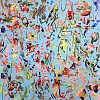


















































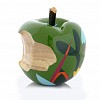




Specialists in contemporary art from South Africa. Established in 1913. South African artists are part of the global conversation. We seek to make their voices heard.

